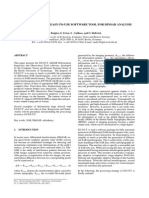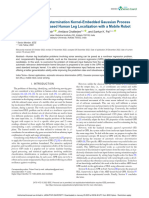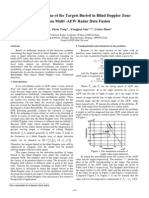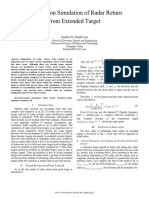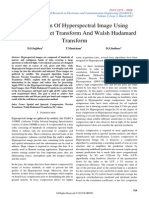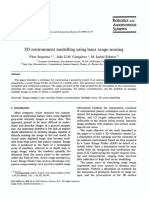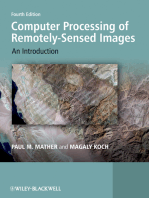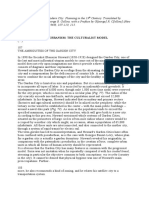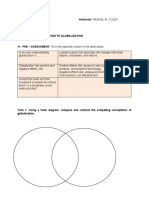High Resolution Radar Cross Section Imaging Based On Complex Target Backscattering Simulation
High Resolution Radar Cross Section Imaging Based On Complex Target Backscattering Simulation
Uploaded by
Yuri BobkovCopyright:
Available Formats
High Resolution Radar Cross Section Imaging Based On Complex Target Backscattering Simulation
High Resolution Radar Cross Section Imaging Based On Complex Target Backscattering Simulation
Uploaded by
Yuri BobkovOriginal Title
Copyright
Available Formats
Share this document
Did you find this document useful?
Is this content inappropriate?
Copyright:
Available Formats
High Resolution Radar Cross Section Imaging Based On Complex Target Backscattering Simulation
High Resolution Radar Cross Section Imaging Based On Complex Target Backscattering Simulation
Uploaded by
Yuri BobkovCopyright:
Available Formats
High Resolution Radar Cross Section Imaging Based
on Complex Target Backscattering Simulation
Jiehao Zhu, Jianjiang Zhou, Weijie Xia
College of Information Science and Technology, Nanjing University of Aeronautics and Astronautics
Nanjing, 210016, P.R. China
zhujh@nuaa.edu.cn
Abstract Pixel Method which is enlightened from the Graphic
Electromagnetic Computing(GRECO) is introduced in this paper
and realized by OpenGL and VC programming. Using
simulation data, the wideband features of the target can be
obtained for radar automatic target recognition(RATR). Some of
the calculated features including RCS, range profile, and SAR
image which are also refered to zero-dimensional image, one-
dimensional image, and two-dimensional image of the target are
discussed in detail. Results show that the task of complex target
backscattering simulation is effective for initial research and
development(R&D) of radar automatic target recognition.
I. INTRODUCTION
There are two main kind of methods for computing Radar
Cross Section(RCS) of complex targets in high frequency
region at present, including accurate mathematical method and
approximate high-frequency method. Accurate mathematical
method contain MoM, FDTD, and FIT etc. The characteristic
of accurate mathematical method is that for complex target
with any shape and material, the result is precise, but limited
to the memory and calculation speed of computer.
Approximate high-frequency method include GO, PO, GTD,
and PTD etc, and can be realized by component method
[1]
,
panel method
[2]
, shooting and bouncing rays method
[3]
, and
pixel method
[4]
etc. Approximate high-frequency method own
advantages of clear physical concepts and explicit expressions.
Radar automatic target recognition R&D requires a mass of
experiments. These experiments are not only expensive, but
hard to control. Task of simulation replacing of experiments is
now widely adopted in initial RATR R&D. By computing the
complex target backscattering for specific radar system,
wideband features can be obtained. They are abundant in
recognizable information, including range profiles, total radar
cross sections, range-polarization profiles, range-frequency
profiles, and two-dimensional images
[5]
etc. High resolution
signatures play an important role in radar automatic target
recognition community.
In this paper, pixel method which is enlightened from the
GRECO
[6]
is applied to compute the complex target
backscattering by OpenGL and VC programming. Compared
with the GRECO, pixel method is based on the given precise
CAD modelling, so it is not constrained to the number of
screen pixels and provide more precision. Using simulation
data, some of the significant imaging signatures are discussed
in detail. In addition, the computing results are compared with
the measured data, which proves the availability of the task. In
section ], the pixel method is introduced and studied. In
section ], |, and , the RCS feature of the target, the
relative motion effect on the range profile of the target, and
the precise imaging of the target in Cartesian coordinate
system are discussed in detail respectively. Finally, we
conclude with summary in section \.
II. BACKSCATTERING SIMULATION OF COMPLEX TARGET
A. Scattering Calculation of the Surface
According to the physical optics technique, backscattering
of a perfectly conducting surface can be approximate in high
frequency by the expression:
( )
0
0
0 0
2
4
jk R
jk r s s i
s
jk Z e
E s s n H e dxdy
R t
=
)
(1)
where
0
k is the wave number of the incident wave, s is the
unit vector from the surface to the observer, n is the normal
to the surface, r is the position vector of the surface, and R
is the distance between the surface and the observer. When
applied to complex target, the surface integral is difficult.
After discretization of surfaces to pixels, the backscattering of
target can be deduced according to GRECO
[6]
:
( )
0
0
0 2 0
0
sin tan
2 tan
jk R
jk z s
pixels
k l jk e
E e
R k l
u
t u
=
_
(2)
where l is the actual length corresponding to the pixel, u
is the angle between the normal to the surface and the
direction of incidence, and z is the distance from the pixel to
the observer projected on the incidence direction. Z-Buffer
technique can be applied to pixel method to realize exact
blanking for the calculation surface acquisition.
B. Diffraction Calculation of the Edge
Equivalent edge currents method
[7]
is adopted to calculate
the edge diffraction. It is realized by line integral:
0
0
0
0
4
jk R
jk r s d
e m
c
jk e
E Z I s s t I s t e dl
R t
( = +
)
(3)
where
t is the tangent unit vector,
e
I and
m
I are the
electric and magnetic equivalent currents, respectively.
Similar to the surface integral, the line integral can be
calculated by the sum of discrete sub-lines. The definition of
e
I and
m
I is:
( )
2
0 0
2
sin '
i
e
e
E t D
I
jk Z |
= (4)
______________________________________
978-1-4244-2193-0/08/$25.00 2008 IEEE
( )
2
0 0
2
sin '
i
m
m
H t D
I
jk Y |
= (5)
respectively, where ' | is the angle between the edge and
the direction of incidence, and
e
D
m
D are scalar diffraction
coefficient given by the PTD. When applied to monostatic
radar, eq.(3) can be decomposed to specific polarization
results
[8]
.
III. RCS OF COMPLEX TARGET
The definition of RCS is:
2
2
2
lim4
s
R i
E
R
E
o t
= (6)
where
s
E is the scattering field intensity. Figure 1. is the
CAD model of one satellite, Figure 2. is the comparison
between the computing results and the measured data.
Parameters are given: the bottom radius and the height of the
satellite approximate 0.3m and 0.8m respectively, and the
radar frequency is 9.0GHz with HH polarization. The
computing results are in close agreement with the measured
data.
Fig. 1 CAD model of the satellite
Fig. 2 Comparison between computing results and measured data
IV. RANGE PROFILE OF COMPLEX TARGET
When radar working at optical region, the scattering
characteristic can be described by scattering centers model.
Acquisition of high resolution information along the range
direction requires wideband signals. Range profile is the IDFT
of the wideband frequency responses. Backscattering of
moving target can be obtained by calculating the precise
distance between radar and target at different time. Relative
motion of the target makes the phase of the backscattering
contain extra linear and high-order components. The extra
linear component leads to range profile shift, and on the other
hand, the high-order component leads to range profile decline
and widening. The extra phase component make both the
resolution and sensitivity of range profile get worse. These
effects seriously affect the stability of the features extracted
from the range profile, and make the recognition more
difficult. Figure 3. is the simulation range profile of the B-52
aircraft at one specific flight attitude, the carrier frequency is
10GHz, the bandwidth is 128MHz, the step frequency is
1MHz, the PRF is 20kHz, and the radial velocity is 50m/s.
Figure 4. is the range profile which has the same parameters
but with velocity compensation.
Fig. 3 Range profile of the moving target
Fig. 4 Range profile with velocity compensation
V. PRECISE IMAGING OF COMPLEX TARGET
In spotlight SAR imaging, when the phase of echoes is
compensated, the sampling data in frequency space are
arranged in a sector region, as show in Figure 5.
8
Fig. 5 Format of sampling data in frequency space
For the sake of improving cross range resolution, the
synthetic aperture needs to be lengthened, and the
corresponding angle of the sampling data in frequency space
also increased. At the same time, lengthening the synthetic
aperture leads to scatters motion through range cells(MTRC).
Performing the Fourier transformation direct to the echoes
leads to blurred images. The reason is that the echoes are
sampled in polar coordinates, but the Fourier transformation is
fit for Cartesian coordinate only. To solve this problem, one
can interpolate the sampling data to the Cartesian coordinate,
then perform the Fourier transformation to interpolation data.
This is the well known Polar Format Algorithm(PFA).
However, the interpolation errors also lead to blurred images.
The essential approach to solve this problem is to direct
sample the echoes in Cartesian coordinate
[9]
, and one can
perform the Fourier transformation immediately to the
sampling data to obtain the high quality imaging. It is
impossible to control the sampling data arranged in Cartesian
coordinate, that is the corresponding frequency and azimuth
are changed with unequal spacing, in actual application, but
possible to control in simulation. The frequency and azimuth
determined in Cartesian coordinate are given:
( )
1/ 2
2 2
ij ij ij
f x y = + (7)
arctan
ij
ij
ij
y
x
u
| |
= |
|
\ .
(8)
where
( )
0 0 0 0
2
0
cos tan sin tan
1 tan
i j
ij
f b
x
u u u u
u
+
=
+
(9)
0
tan
ij ij j
y x b u = + (10)
0
1
2 1
i
B i
f f B
M
= +
(11)
0 0
1
1
j
j
b b b
N
= +
(12)
1, 2, ,
1, 2, ,
i M
j N
=
=
0
u and u A stands for center azimuth and azimuth range,
0
f and B stands for carrier frequency and bandwidth
respectively.
0.1m0.1m resolution SAR images of one kind of aircraft
using PFA method and sampling in Cartesian coordinate are
presented in Figure 6. and Figure 7. respectively. The blurs at
wing tips in Figure 6. are caused by the interpolation errors
when using PFA method, and the sampling in Cartesian
coordinate method perform better imaging quality.
Fig. 6 PFA imaging
Fig. 7 Cartesian coordinate sampling imaging
VI. CONCLUSIONS
In this paper, Pixel Method is introduced to compute the
backscattering of complex target. Using simulation data, the
RCS feature of the target, the relative motion effect on the
range profile of the target, and the precise imaging of the
target in Cartesian coordinate system are discussed in detail.
The results show that the task of target backscattering
simulation is effective for initial research and development of
the radar automatic target recognition.
ACKNOWLEDGMENT
This work is supported by the Academician Foundation of
the 14th Research Institute of CETC.
REFERENCES
[1] Yulia V. Zhulina, 3D Visualization of Radar Backscattering Diagrams
Based on OpenGL, EURASIP Journal on Applied Signal Processing,
vol. 2004, Mar 2004, pp. 358-365
9
[2] Jianjiang Zhou, Yongze Shu, Radar Cross Section Computations of
Arbitrarily Complicated Objects by Applying the Panel Method,
Journal of Electronics, vol. 14, Jan 1992, pp. 71-75
[3] Yinbiao Hu, Haisong Ang, Zhanjiu Sun, and Wanbo Liu, RCS
Calculation of Complex Objects Based on SBR and Pixel Method,
Systems Engineering and Electronics, vol. 27, Feb 2005, pp. 247-249
[4] Haisong Ang, Yongze Shu, Jianjiang Zhou, and Yun Peng, A New
Method for RCS Prediction of Complex Objects Curved Surface
Pixel Method, Journal of Electronics and Information Technology, vol.
23, Oct 2001, pp. 962-969
[5] Y. D. Shirman, Computer Simulation of Aerial Target Radar Scattering,
Recognition, Detection, and Tracking, Artech House, Boston MA,
2002.
[6] Juan M. Rius, Miguel Ferrando, and Luis Jofre, High-Frequency RCS
of Complex Radar Targets in Real-Time, IEEE Trans. on Antennas
and Propagation, vol. 41, Sept 1993, pp. 1308-1319
[7] Arie Michael, Equivalent Edge Currents for Arbitrary Aspects of
Observation, IEEE Trans. on Antennas and Propagation, vol. 32, Mar
1984, pp. 252-258
[8] Dehua Qin, Baofa Wang, and Juntie Liu, Improvements of Edges
Detecting and Diffraction Field Computing in GRECO, ACTA
Electronica Sinica, vol. 31, Aug 2003, pp. 1160-1163
[9] Jianjiang Zhou, Zhaoda Zhu, and Yongze Shu, Improvement of
Calculated 2-D Radar Image for Large Rotating Angle, Journal of
Nanjing University of Aero. and Astro., vol. 31, Dec 1999, pp. 655-659
80
You might also like
- SAR Image Formation Toolbox For MATLABDocument13 pagesSAR Image Formation Toolbox For MATLABLissete VergaraNo ratings yet
- DFS Algorithm For GraphDocument4 pagesDFS Algorithm For GraphMayank ChauhanNo ratings yet
- Center For Signal and Image Processing Georgia Institute of Technology Atlanta, GA 30332-0250 USADocument5 pagesCenter For Signal and Image Processing Georgia Institute of Technology Atlanta, GA 30332-0250 USAccdf09No ratings yet
- Study On Multi Scattering Point Modeling For Target in Fuze RF Simulation and Its ApplicationDocument4 pagesStudy On Multi Scattering Point Modeling For Target in Fuze RF Simulation and Its ApplicationAlex YangNo ratings yet
- Radar Tomography For The Generation of Three-Dimensional ImagesDocument7 pagesRadar Tomography For The Generation of Three-Dimensional ImagesMuhammad RosliNo ratings yet
- Imaging Radar Simulation in Realistic Environment Using Shooting and Bouncing Rays TechniqueDocument7 pagesImaging Radar Simulation in Realistic Environment Using Shooting and Bouncing Rays TechniqueAsd DsaNo ratings yet
- Calibration For Increased Accuracy of The Range Imaging Camera SwissrangerDocument6 pagesCalibration For Increased Accuracy of The Range Imaging Camera SwissrangerEgemet SatisNo ratings yet
- Spherical Wave Near-Field Imaging and Radar Cross-Section MeasurementDocument6 pagesSpherical Wave Near-Field Imaging and Radar Cross-Section Measurementoyavuz38No ratings yet
- Angular Glint Modeling and Simulation For Complex Targets: Junji Chen, Fang Yang, Kai Zhang and Jiadong XuDocument3 pagesAngular Glint Modeling and Simulation For Complex Targets: Junji Chen, Fang Yang, Kai Zhang and Jiadong XuAlex YangNo ratings yet
- 11 Chapter 4Document16 pages11 Chapter 4mani567No ratings yet
- A Comparison On Radar Range Profiles Between In-Flight Measurements and RCS-predictionsDocument8 pagesA Comparison On Radar Range Profiles Between In-Flight Measurements and RCS-predictionsHein NyiNo ratings yet
- ISAR Imaging and Range-Doppler Processing of Air TargetsDocument6 pagesISAR Imaging and Range-Doppler Processing of Air TargetsIJRASETPublicationsNo ratings yet
- Catia Aided Radome Analysis Using Geometric Optics MethodDocument5 pagesCatia Aided Radome Analysis Using Geometric Optics MethodAbrham Yair Aguilar RodriguezNo ratings yet
- A Survey On Wireless Position EstimationDocument20 pagesA Survey On Wireless Position EstimationMona GuptaNo ratings yet
- Resolution Adjustable 3D Scanner Based On Using Stereo CamerasDocument5 pagesResolution Adjustable 3D Scanner Based On Using Stereo Camerasverze1No ratings yet
- ISARDocument11 pagesISARGouse BujjiNo ratings yet
- Matas Bmvc02Document10 pagesMatas Bmvc02kkarthiksNo ratings yet
- I.D.I.O.T.: A Free and Easy-To-Use Software Tool For Dinsar AnalysisDocument7 pagesI.D.I.O.T.: A Free and Easy-To-Use Software Tool For Dinsar AnalysisGabriel CiprianNo ratings yet
- InsarDocument12 pagesInsarPercy PeraltaNo ratings yet
- The Fuze Doppler Echo Algorithm of Near-Field Electromagnetic Scattering ModelDocument5 pagesThe Fuze Doppler Echo Algorithm of Near-Field Electromagnetic Scattering Modelتپل خستهNo ratings yet
- Ship Detection Based On Morphological Component Analysis of High-Frequency Surface Wave Radar ImagesDocument9 pagesShip Detection Based On Morphological Component Analysis of High-Frequency Surface Wave Radar ImagesRaghul RamasamyNo ratings yet
- Improvements in Radar Observing Capabilities: Mtech (DC), BMSCEDocument32 pagesImprovements in Radar Observing Capabilities: Mtech (DC), BMSCEVivekananda HkNo ratings yet
- Ynthetic Aperture Radar On Low PowerDocument6 pagesYnthetic Aperture Radar On Low Powerharsha vardhanNo ratings yet
- Proceedings of Spie: Low-Cost Precision Rotary Index CalibrationDocument7 pagesProceedings of Spie: Low-Cost Precision Rotary Index CalibrationdidactechboliviaNo ratings yet
- Automatic Relevance Determination Kernel-Embedded Gaussian Process Regression For Sonar Based Human Leg Localization With A Mobile RobotDocument4 pagesAutomatic Relevance Determination Kernel-Embedded Gaussian Process Regression For Sonar Based Human Leg Localization With A Mobile RobotPRITAM PARALNo ratings yet
- Lidar Iris For Loop-Closure DetectionDocument7 pagesLidar Iris For Loop-Closure Detectionpepepe123jkghjkhNo ratings yet
- SAR Image Simulation With Application To Target ReDocument24 pagesSAR Image Simulation With Application To Target ReDenis GrigorenkoNo ratings yet
- Ieee 65Document4 pagesIeee 65hasan1100No ratings yet
- Multi-Source Image Registration Based On Log-Polar Coordinates and Extension Phase Correlation PDFDocument7 pagesMulti-Source Image Registration Based On Log-Polar Coordinates and Extension Phase Correlation PDFivy_publisherNo ratings yet
- Time Domain Back Projection Algorithms For SARDocument4 pagesTime Domain Back Projection Algorithms For SARnaivedya_mishraNo ratings yet
- Potential of Digital Holography in Particle Measurement: Shigeru Murata, Norifumi YasudaDocument8 pagesPotential of Digital Holography in Particle Measurement: Shigeru Murata, Norifumi YasudarajachakrabortyNo ratings yet
- Research On Simulation of Radar Return From Extended Target: Xiaohui Yu, Pengfei LuoDocument4 pagesResearch On Simulation of Radar Return From Extended Target: Xiaohui Yu, Pengfei LuoAlex YangNo ratings yet
- Real Time Radar ImagingDocument11 pagesReal Time Radar ImagingSatya PattanayakNo ratings yet
- Underground Diseases Identification of Airport Runway Using GPRDocument5 pagesUnderground Diseases Identification of Airport Runway Using GPRapi-61200414No ratings yet
- Radargrammetry and Sar InterferommetryDocument6 pagesRadargrammetry and Sar InterferommetryvrixscribdNo ratings yet
- Imeko TC10 2014 020Document6 pagesImeko TC10 2014 020nhuNo ratings yet
- Global Localization Using Local Pole PatternsDocument10 pagesGlobal Localization Using Local Pole Patternsvictor calan ucNo ratings yet
- Ractal Image Compression Using Uadtree Decomposition and Huffman CodingDocument6 pagesRactal Image Compression Using Uadtree Decomposition and Huffman CodingSylvain KamdemNo ratings yet
- Greco Ieee 1993Document11 pagesGreco Ieee 1993opedroestebanNo ratings yet
- Progress in Electromagnetics Research, Vol. 140, 63-89, 2013Document27 pagesProgress in Electromagnetics Research, Vol. 140, 63-89, 2013Sandip MaityNo ratings yet
- IJE Volume 36 Issue 9 Pages 1589-1596 4Document8 pagesIJE Volume 36 Issue 9 Pages 1589-1596 4EXAM SECTIONNo ratings yet
- Efficient Stripmap SAR Raw Data Generation Taking Into Account Sensor Trajectory DeviationsDocument5 pagesEfficient Stripmap SAR Raw Data Generation Taking Into Account Sensor Trajectory Deviationsmani567No ratings yet
- 26 Pics 2000 BurnsDocument4 pages26 Pics 2000 Burnslolopopo28No ratings yet
- Body AreaDocument5 pagesBody AreaAmmu RaviNo ratings yet
- Ijarece Vol 2 Issue 3 314 319Document6 pagesIjarece Vol 2 Issue 3 314 319rnagu1969No ratings yet
- GRNN For Forecasting Resonance Frequency of Circular Patch AntennaDocument4 pagesGRNN For Forecasting Resonance Frequency of Circular Patch AntennaShruthy ReddyNo ratings yet
- DSDPKDocument8 pagesDSDPK363331272No ratings yet
- Ijecet: International Journal of Electronics and Communication Engineering & Technology (Ijecet)Document7 pagesIjecet: International Journal of Electronics and Communication Engineering & Technology (Ijecet)IAEME PublicationNo ratings yet
- Euclidean DistanceDocument10 pagesEuclidean Distanceabyss2000No ratings yet
- Range Migration Algorithm For Airborne Squint Mode Spotlight SAR ImagingDocument6 pagesRange Migration Algorithm For Airborne Squint Mode Spotlight SAR ImagingShanu ShaNo ratings yet
- A Novel Application of Lifting Scheme For Multiresolution Correlation of Complex Radar SignalsDocument11 pagesA Novel Application of Lifting Scheme For Multiresolution Correlation of Complex Radar SignalsAnil KumarNo ratings yet
- Synthetic Aperture Radar Principles and Applications of AI in Automatic Target RecognitionDocument6 pagesSynthetic Aperture Radar Principles and Applications of AI in Automatic Target RecognitionoveiskntuNo ratings yet
- Range Image Acquisition With A Single Binary-Encoded Light PatternDocument17 pagesRange Image Acquisition With A Single Binary-Encoded Light PatternNirvana NguyenNo ratings yet
- 基于互相关的反向投影算法Document6 pages基于互相关的反向投影算法hyperboliiic111No ratings yet
- Sar Tomography: An Advanced Tool For 4D Spaceborne Radar Scanning With Application To Imaging and Monitoring of Cities and Single BuildingsDocument9 pagesSar Tomography: An Advanced Tool For 4D Spaceborne Radar Scanning With Application To Imaging and Monitoring of Cities and Single BuildingsfakeNo ratings yet
- Robotics Autonomous Systems: V Tor Sequeira A,,, Joao G.M. Gon Alves A, M. Isabel Ribeiro BDocument11 pagesRobotics Autonomous Systems: V Tor Sequeira A,,, Joao G.M. Gon Alves A, M. Isabel Ribeiro BUmesh SharmaNo ratings yet
- Bad GeometryDocument5 pagesBad GeometryMilica PopovicNo ratings yet
- Cramer Rao Bound On Target Localization Estimation in MIMO Radar SystemsDocument6 pagesCramer Rao Bound On Target Localization Estimation in MIMO Radar Systemsprobability2No ratings yet
- Procedural Surface: Exploring Texture Generation and Analysis in Computer VisionFrom EverandProcedural Surface: Exploring Texture Generation and Analysis in Computer VisionNo ratings yet
- Computer Processing of Remotely-Sensed Images: An IntroductionFrom EverandComputer Processing of Remotely-Sensed Images: An IntroductionNo ratings yet
- Topics On Optical and Digital Image Processing Using Holography and Speckle TechniquesFrom EverandTopics On Optical and Digital Image Processing Using Holography and Speckle TechniquesNo ratings yet
- Class 6 Science Chapter 2 Revision NotesDocument4 pagesClass 6 Science Chapter 2 Revision NotesPraveen SNo ratings yet
- 2 - Thermal Energy Storage SystemsDocument21 pages2 - Thermal Energy Storage SystemsAbed NaemNo ratings yet
- Confirmation For Booking ID # 843643049Document1 pageConfirmation For Booking ID # 843643049cindy brigitaNo ratings yet
- Gtaw 03Document40 pagesGtaw 03பத்மநாபன் ஶ்ரீநிவாஸன்No ratings yet
- SCA Technical Spec GE Frame 9E S Rev1 9e SpecificationDocument144 pagesSCA Technical Spec GE Frame 9E S Rev1 9e Specificationzhangj5100% (3)
- Tyco Int. ScandalDocument21 pagesTyco Int. ScandalKhaleda Ruma100% (1)
- Secrets of The SiddhasDocument1 pageSecrets of The SiddhasChiranth ChandNo ratings yet
- Despite: 1. He Won't Pass The Test Because He Doesn't Work Hard EnoughDocument2 pagesDespite: 1. He Won't Pass The Test Because He Doesn't Work Hard EnoughChristian Gonzalez100% (1)
- UntitledDocument234 pagesUntitledMarco Antonio AlvarezNo ratings yet
- Choay Modern City BDocument4 pagesChoay Modern City BEdwing MartellNo ratings yet
- SW Project ManagementDocument64 pagesSW Project ManagementVignesh DksNo ratings yet
- Encana LPG MSDSDocument2 pagesEncana LPG MSDSarini_aristia_sNo ratings yet
- Budgeting 180116052926Document32 pagesBudgeting 180116052926Abhijeet Sen Gupta100% (1)
- Hydrodynamic Research Project: OngoingDocument3 pagesHydrodynamic Research Project: OngoingOdumoduChigozieUzomaNo ratings yet
- Museum of Contemporary Art Bahrain by Zaha Hadid ArchitectsDocument7 pagesMuseum of Contemporary Art Bahrain by Zaha Hadid ArchitectsEmiliano_Di_Pl_3393No ratings yet
- Urban DesignDocument11 pagesUrban DesignIshteyak AlamNo ratings yet
- 04 Karachi Members Mechanical AlliedDocument17 pages04 Karachi Members Mechanical AlliedFarahat Khan100% (1)
- ESG ReportDocument9 pagesESG ReportSourish BurmanNo ratings yet
- Unit 16 Disasters and Development: 16.0 Learning OutcomeDocument18 pagesUnit 16 Disasters and Development: 16.0 Learning OutcomePrincipal AveriNo ratings yet
- 00 R80 Training AgendaDocument6 pages00 R80 Training AgendaThịnh Nguyễn XuânNo ratings yet
- Glass Ionomer CementDocument1 pageGlass Ionomer Cementcelia cinantyaNo ratings yet
- GEConWorld CieloDocument7 pagesGEConWorld CieloRuth VirtudazoNo ratings yet
- Set Theory: Basic, Essential, and Important Properties of SetsDocument48 pagesSet Theory: Basic, Essential, and Important Properties of SetsRusheel Chava100% (1)
- Technical Report For A Structural Design ProjectDocument95 pagesTechnical Report For A Structural Design ProjectHayman AhmedNo ratings yet
- Lesson 3.1 Major Development and Personalities in S&T in The PhilippinesDocument36 pagesLesson 3.1 Major Development and Personalities in S&T in The PhilippinesSittie Junairah AguinoNo ratings yet
- CIVL 3121 - Syllabus - Fall 2019: InstructorDocument2 pagesCIVL 3121 - Syllabus - Fall 2019: InstructorahmedajelNo ratings yet
- Abm-Applied Economics 12 q1 w2 Mod2Document15 pagesAbm-Applied Economics 12 q1 w2 Mod2SanchinoDeeNo ratings yet
- GFF - Orc Marauders 3.3.1Document5 pagesGFF - Orc Marauders 3.3.1Ana Clara RodriguesNo ratings yet
- Bloodcharts CMP PDFDocument1 pageBloodcharts CMP PDFSujay DhumalNo ratings yet

















